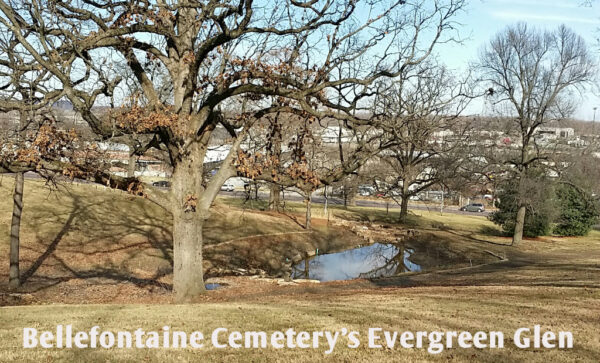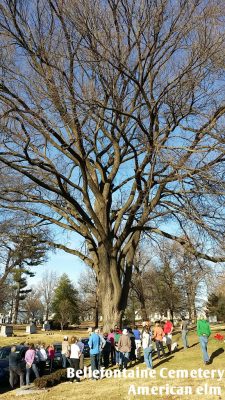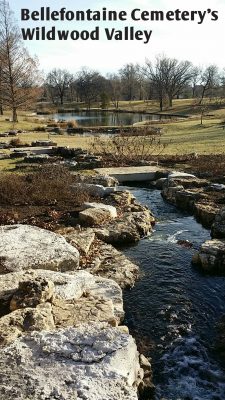By Marcia K. Myers
Blog Editor, Wild Ones – St. Louis Chapter
 With a mostly clear, sunny sky and an unusually warm 72 degree day on Saturday, January 21, about 32 attendees stood near a persimmon tree (Diospyros virginiana) listening to Kyle Cheesborough, ISA certified arborist and the horticulture supervisor for the Bellefontaine Cemetery and Arboretum. Marsha Gebhardt, James Faupel, and Dawn Weber of the Wild Ones – St. Louis Chapter’s board and members April Anderson and I carpooled to the various sites. Other Wild Ones members attended as well.
With a mostly clear, sunny sky and an unusually warm 72 degree day on Saturday, January 21, about 32 attendees stood near a persimmon tree (Diospyros virginiana) listening to Kyle Cheesborough, ISA certified arborist and the horticulture supervisor for the Bellefontaine Cemetery and Arboretum. Marsha Gebhardt, James Faupel, and Dawn Weber of the Wild Ones – St. Louis Chapter’s board and members April Anderson and I carpooled to the various sites. Other Wild Ones members attended as well.
During this native plant tour, Cheesborough was explaining how the brown, leaf-strewn ground around us had been seeded and is being transformed into a meadow. They contracted with DJM Ecological Services for multiple services, which includes seeding and weed management for the first two seasons.
 Native plants seem especially appropriate for those who want to minimize their impact on the environment by choosing this green burial section (Evergreen Meadow) and forgoing embalming and the modern casket. Using shorter grass species such as little blue stem (Schizachyrium scoparium) ensures easier access to the site by loved ones. Also, forbs geared toward host and nectar plants provide better habitat. The meadow has about 50 species of plants and will be mowed as late as possible in the spring. At some point, the cemetery will request official permission to burn it.
Native plants seem especially appropriate for those who want to minimize their impact on the environment by choosing this green burial section (Evergreen Meadow) and forgoing embalming and the modern casket. Using shorter grass species such as little blue stem (Schizachyrium scoparium) ensures easier access to the site by loved ones. Also, forbs geared toward host and nectar plants provide better habitat. The meadow has about 50 species of plants and will be mowed as late as possible in the spring. At some point, the cemetery will request official permission to burn it.
Looking further into the distance, a “giant rain garden” contains standing water at the bottom of a sloping landscape. The area captures storm water runoff from nine and one-half acres, and the cemetery is creating a woodland and prairie area. The Missouri Department of Conservation provided funding for the planting of this storm-water capture project, which Cheesborough said they affectionately refer to as Evergreen Glen. Bellefontaine Cemetery and Arboretum was founded in 1849 during the Rural Cemetery Movement where creating a peaceful, natural environment was the desired effect. Although that is still the case, how that looks is changing.
Cheesborough said they planted a little more than 500 shrubs and 230 trees last fall, mostly native. They try to source as local as possible. However, some plants are cultivars.They have a large section of oaks and a Missouri state champion American elm (Ulmus americana).
Being a Level II Arboretum, according to ArbNet, means that Bellefontaine “has at least 100 species of woody plants, employs paid staff, and has enhanced public education programs and a documented collections policy.”
 Anyone can stop by the office during open hours and pick up cemetery and arboretum tour maps. We were there for the plants, but the cemetery has some notable historical grave sites, such as William Clark whose monument was built in 1904 for the World’s Fair. Bellefontaine’s visiting hours are 8:00 a.m. through 5:00 p.m. every day of the year, including weekends and holidays.
Anyone can stop by the office during open hours and pick up cemetery and arboretum tour maps. We were there for the plants, but the cemetery has some notable historical grave sites, such as William Clark whose monument was built in 1904 for the World’s Fair. Bellefontaine’s visiting hours are 8:00 a.m. through 5:00 p.m. every day of the year, including weekends and holidays.
If you go be sure to see Wildwood Valley, which creates a peaceful, picturesque section of the cemetery with its structures, water features including a fountain, and winding pathways. It’s a botanical-style garden with a Midwestern flair. The goal is to plant 70 percent native and 30 percent exotic species with natives such as Liatris spp., Echinacea spp., Hamamelis spp., and Baptisia spp.
With all of this increasingly attractive habitat, many different animals have been spotted on the property, including possibly up to 130 species of birds (not confirmed), a number Cheesborough gave us to illustrate the diversity. Other animals include fox which like to lounge on the warm stones, and three species of owls: barred, great horned, and screech.
The tour was sponsored by Grow Native!, which Wild Ones – St. Louis Chapter is now an Institutional member (more on this in another blog post). Thank you to Carol Davit, the Executive Director of the Missouri Prairie Foundation for her introduction and to Kyle Cheesborough for the tour.


Wonderful seeing how the historical purpose of Bellefontaine Cemetery is being created today within the habitats of meadow, glen and valley. And with emphasis on Missouri native plants it certainly is a showcase for all to enjoy, including animal and insect species. A peaceful and natural setting for all.